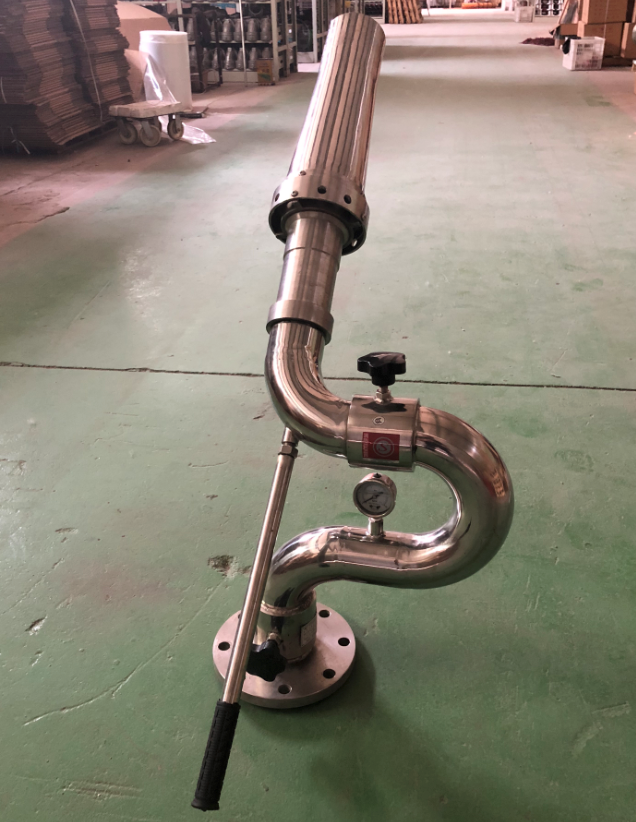How to Use Venturi Effect to Extinguish Fire with Self priming foam Fire Monitor
In the realm of firefighting equipment, the self-priming foam fire monitor stands out for its versatility and effectiveness in combating liquid and solid fires. This specialized apparatus integrates advanced engineering principles, particularly the Venturi effect, to autonomously aspirate foam concentrate and air, generating stable foam streams for rapid fire suppression. This article delves into the core components, operational mechanism, and key applications of self-priming foam fire monitors, elucidating their significance in safeguarding critical infrastructures.
Key Components
A typical self-priming foam fire monitor comprises:
Handle: Enables manual control and adjustment of direction.
Base: Provides stable mounting support, often integrated with rotation mechanisms.
Inlet Pipe: Connects to pressurized water source (≥1.0 MPa).
Swivel Body: Facilitates 360° rotation and elevation adjustments (-90° to +75°) for precise targeting.
Locking Device: Secures operational angles to prevent unintended movement.
Tapered Nozzle Section: The crucial element where Venturi effect occurs, featuring a variable diameter passage.
Suction Tube: Connects to foam concentrate tank, aspirating the agent via generated负压.
Operating Principle: The Power of Venturi Effect
The self-priming function hinges on the Venturi principle, a fluid dynamics phenomenon where a reduction in pipe diameter accelerates fluid velocity, simultaneously reducing static pressure (Bernoulli's equation). Steps of operation:
Pressurized Water Flow: Water enters through the inlet pipe, accelerating through the tapered nozzle section.
Negative Pressure Generation: As water velocity peaks at the constriction point (throat of the Venturi tube), static pressure plunges, creating a vacuum.
Foam Concentrate Aspiration: The suction tube, connected to the low-pressure zone, draws foam concentrate from the reservoir (typically at 3-6% mixture ratio).
Premixing: Water and concentrate mix within the monitor's internal chamber, forming a homogeneous solution.
Air Induction & Foam Expansion: Downstream of the mixing chamber, another Venturi element induces air, transforming the mixture into voluminous, heat-resistant foam.
Projected Foam Stream: The high-expansion foam is ejected through the nozzle, adhering to fuel surfaces to smother fires through cooling and oxygen deprivation.

Technical Highlights
Autonomous Operation: Eliminates the need for external foam proportioning systems, enhancing response speed.
Variable Nozzle Design: Tapered sections (e.g., conical or stepped) optimize pressure drop for consistent foam quality.
Corrosion-Resistant Materials: Components (SS304, EPDM seals) withstand harsh environments and foam chemical exposure.
Quick Deployment: Suitable for mobile units or fixed installations with remote control capabilities.
Application Scenarios
Self-priming foam fire monitors are indispensable in high-risk environments:
Petrochemical Facilities: Suppressing flammable liquid fires in storage tanks, refineries, and loading terminals.
Marine & Ports: Protecting oil rigs, tanker terminals, and shipyards against spills and deck fires.
Airport Hangars: Mitigating aviation fuel fires with rapid foam coverage.
Large-Scale Warehouses: Combating Class B fires (solvents, oils) in storage facilities.
Industrial Plants: Safeguarding flammable production lines and chemical processing areas.
Emergency Response Units: Integrated into firefighting trucks for tactical deployment in complex fire scenarios.
Compliance & Safety Notes
Must adhere to NFPA 11 & EN 13565-2 standards for foam system design.
Suction tubes require priming agents or check valves to prevent backflow.
Periodic tests ensure Venturi throat integrity and foam discharge efficiency.
Avoid deployment in environments with water-reactive substances (e.g., metal sodium storage).
Conclusion
The self-priming foam fire monitor’s reliance on Venturi-induced负压 revolutionizes firefighting by streamlining foam generation and delivery. Its autonomy, precision, and adaptability make it a cornerstone in protecting assets and personnel across industries. As technology evolves, integrating IoT sensors and AI targeting systems further enhances its effectiveness, solidifying its role as a vital tool in modern fire suppression strategies.
- Manual Fire Cannon Models Configuration and Application
- Which Fire Monitor is Best for Fire Trucks
- What are the Characteristics of the Top 10 Fire Water Monitor Manufacturers in China
- Fixed Fire Cannon
- Two or three items about the acceptance of explosion-proof fixed fire monitors
- Analysis of Intelligent Fire Water Cannon Model Selection



